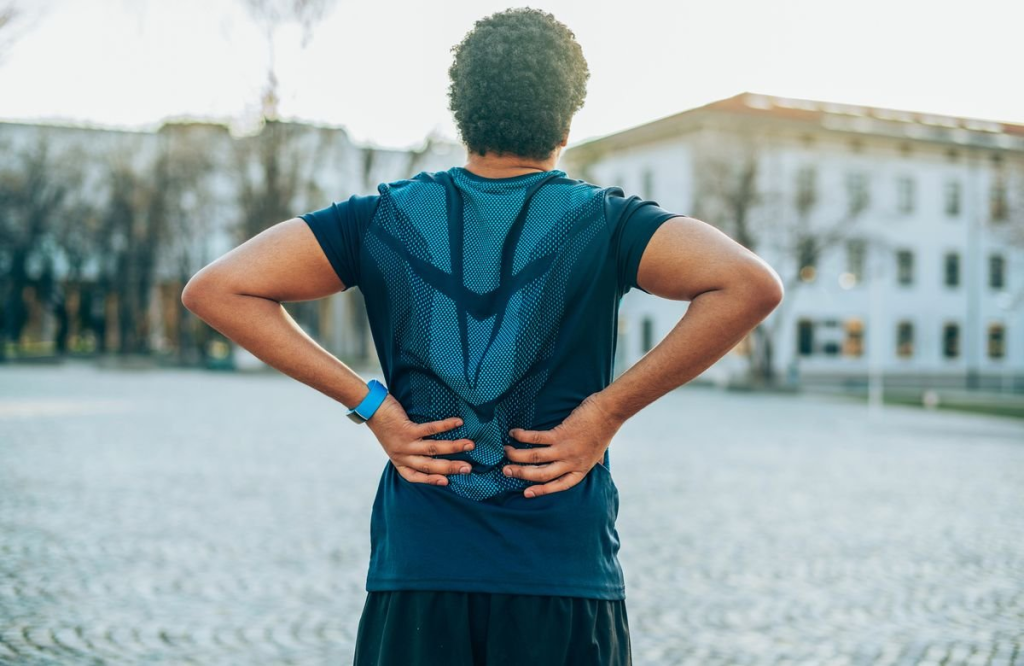Why Is Low Back Pain So Common in Athletes?
Why Do Athletes Develop Low Back Pain?
Whether you’re running, lifting, swimming, or playing a sport like cricket or football, your lower back works hard to support your body. It helps you move, twist, bend, and absorb shock. But sometimes, it gets pushed too far — leading to pain or injury.
Here are some common reasons athletes develop low back pain:
- Overuse and repetition: Repeating the same movements, like swinging a bat or running long distances, can wear down the muscles and joints in your back.
- Poor technique: Lifting or moving with bad posture puts extra pressure on the spine.
- Weak core muscles: Your lower back takes on more load if your abdominal and hip muscles aren’t strong enough to support you.
- Sudden injuries: Falls, bad landings, or collisions can cause sudden damage.
- Too much, too soon: Quickly increasing your training intensity or volume can overload your spine before it’s ready.
How Low Back Pain Shows Up in Different Sports

Not all back pain is the same. Depending on the sport, different parts of the spine may be affected. Let’s look at what causes pain in popular sports:
Cricket
- Common injuries: Stress fractures, muscle strain, disc irritation
- Why it happens: Fast bowlers twist and bend their spines repeatedly. Wicketkeepers stay in a crouched position for hours, which strains back muscles.
Prevention Tip: Improve technique, strengthen your core, and take rest days seriously.
Weightlifting, CrossFit, Powerlifting
Common injuries: Muscle strain, herniated discs, joint sprains
- Why it happens: Lifting heavy weights with poor form or jerky movements puts enormous stress on the spine.
Prevention Tip: Focus on form first. Lift smart, not just heavy.
Golf and Tennis
- Common injuries: Facet joint stress, muscle tightness, disc pressure
- Why it happens: These sports involve twisting in one direction over and over, which causes imbalances.
Prevention Tip: Stretch regularly and work on both sides of the body to stay balanced.
Swimming
- Common injuries: Stress fractures, overuse strain, back arching problems
- Why it happens: Some strokes, like butterfly or breaststroke, require repeated spinal extension, especially if core strength is weak.
Prevention Tip: Strengthen your core and pay attention to stroke technique.
Football, Volleyball
- Common injuries: SI joint pain, muscle pulls, disc injuries
- Why it happens: Sudden movements, jumps, and tackles challenge spinal stability.
Prevention Tip: Do a proper warm-up and build total-body strength.
Running and Track Sports
- Common injuries: SI joint irritation, tight muscles, stress injuries
- Why it happens: Running with poor posture or on uneven ground puts stress on the spine over time.
Prevention Tip: Get your running form checked and don’t skip strength training.
Rowing and Kayaking
- Common injuries: Disc pain, tightness, muscle fatigue
- Why it happens: These sports involve a lot of bending and pulling, which can wear down the spine without proper technique.
Prevention Tip: Keep your posture in check and strengthen your back and core.
When Should You See a Physiotherapist?
Some back soreness after a workout is normal. But you should see a physiotherapist if you notice:
- Pain lasting more than a few days
- Discomfort that limits your training or daily tasks
- Numbness, tingling, or leg weakness
- Pain that keeps coming back, even after rest
Early treatment can prevent small issues from becoming bigger problems.
How Physiotherapy Can Help Your Low Back Pain
At Rehab Station, we don’t just treat your symptoms — we treat the root cause. Here’s how we help athletes recover and return to sport safely:
- ✔️ Thorough assessment of posture, strength, and movement
- ✔️ Manual therapy to reduce pain and restore flexibility
- ✔️ Core and spine-specific strengthening programsKnow more
- ✔️ Education on safe technique and training habits
- ✔️ A step-by-step plan for your return to sport — stronger and more confident Take a look
We also focus on preventing future injuries, so you can keep doing what you love.
Patient Story: Radhika’s Comeback from a Disc Injury
Radhika Gotkhinidkar, a 22-year-old powerlifter and final-year physiotherapy student, injured her lower back while lifting. The pain was so intense that she couldn’t manage daily activities — and she feared she might need surgery.
When she came to Rehab Station, she was assessed by Dr. Aditi Dole (PT). Her rehab plan included:
- Spinal stabilization
- Core strengthening
- Postural correction
- Gradual reintroduction of lifting techniques
Over time, Radhika not only recovered, but came back stronger. She now lifts without pain — and with a new appreciation for the rehab process. As a future physiotherapist herself, her experience has made her more empathetic and aware of how recovery feels, both physically and emotionally.
Watch Radhika’s journey on Instagram
✅ Key Takeaway Low back pain in athletes is common — but it doesn’t have to hold you back.
Understand how your sport affects your spine. Work on technique, core strength, and recovery. And if you’re in pain, don’t ignore it.
Reach out to a physiotherapist early — it can make all the difference in your performance and long-term health.
- Dr. Safoora Parkar (PT)
Rehab Station
